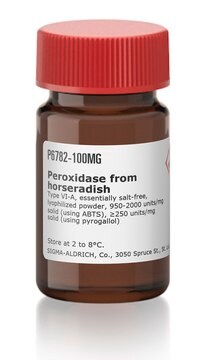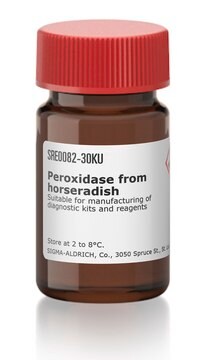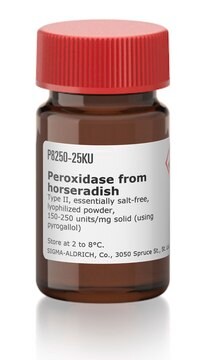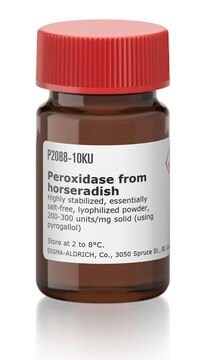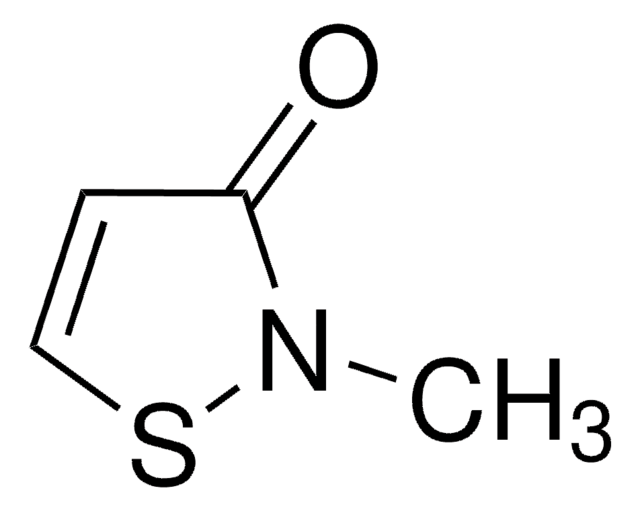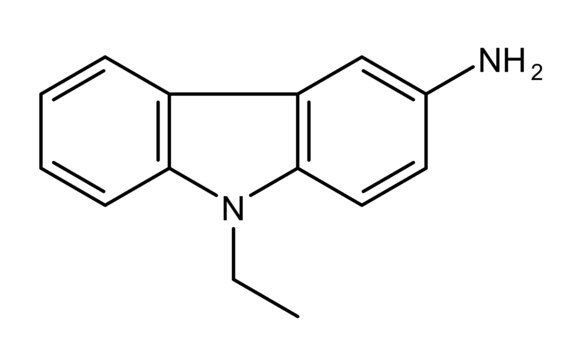おすすめの製品
使用法
sufficient for 5 labeling reactions
品質水準
比活性
800 U/mg (800 U/mg protein at +25°C and pH 5.0 with ABTS and H2O2 as substrates.)
800 units/mg protein (At 25 °C and pH 5.0 with ABTS and H<sub>2</sub>O<sub>2</sub> as substrates.)
包装
kit of 1 (7 components)
メーカー/製品名
Roche
テクニック
ELISA: suitable
immunoblotting: suitable
immunohistochemistry: suitable
保管温度
2-8°C
詳細
Peroxidase Labeling Kit(ペルオキシダーゼ標識キット)は、西洋わさび由来の活性化ペルオキシダーゼ(POD)を用いて生体分子の第一級アミノ基の標識を行うことができます。
特異性
純度:(A405nm/A275nm):3.0 ~ 3.5。
アイソザイムの分布:> 90%均一な アイソザイムC。
アッセイ時間:手順は反応温度+25°Cのために開発されました。+25°Cでは反応時間は2時間ですが、結果に影響を与えずに3時間まで延長が可能です。別の方法として、反応を+2~+8°Cで、反応時間を18時間から24時間までにして実施することもできます。
アイソザイムの分布:> 90%均一な アイソザイムC。
アッセイ時間:手順は反応温度+25°Cのために開発されました。+25°Cでは反応時間は2時間ですが、結果に影響を与えずに3時間まで延長が可能です。別の方法として、反応を+2~+8°Cで、反応時間を18時間から24時間までにして実施することもできます。
アプリケーション
Peroxidase Labeling Kit(ペルオキシダーゼ標識キット)は、分析法で使用するために露出している反応性第一級アミノ基を持つ水溶性生体分子(例:ペプチドやタンパク質)をペルオキシダーゼで標識するようにデザインされています。特にペルオキシダーゼを用いた抗体のカップリングに適していますが、これは得られる錯体が以下のような免疫化学検出系での使用に適しているからです:
- ELISA(酵素結合免疫吸着測定法)
- 免疫組織化学
- イムノブロッティング
特徴および利点
- 迅速 - 全標識手順を1日で実施できます
- 簡単 - わずか5段階のシンプルな作業
- 完全 - キットには必要なバッファーや試薬がすべて含まれます
包装
1キットに7回の反応分が含まれています。
- ペルオキシダーゼ(活性型)
- 炭酸ナトリウム/炭酸水素バッファー
- 水素化ホウ素ナトリウム(錠剤)
- トリエタノールアミンバッファー
- グリシン溶液
- 透析バッファー
- 安定化剤(BSAおよびKathon CG含有)
調製ノート
Working solution: Preparation of working solutions
For best results, mark each solution with the appropriate number. Volumes indicated are sufficient to label a portion of 1.2 mg IgG.
Solution 1: Peroxidase (activated)
Reconstitute the lyophilizate of bottle 1 in 0.5 ml double-distilled water (peroxidase concentration = 16 mg/ml).
Solution 2: Sodium Carbonate/-hydrogencarbo-nate Buffer (100 mM, pH 9.8)
Equilibrate bottle 2 to 15 to 25 °C. Be sure that all buffer components are dissolved. Add 10 ml of bottle 2 to 90 ml double-distilled water, mix well.
Solution 3: Sodium Borohydride Solution (200 mM)
We recommend to wear gloves when working with sodium borohydride. Prepare the solution immediately prior to use and keep cold on ice. Add 1 tablet of bottle 3 to 130 ml cold, double-distilled water, mix well.
Solution 4: Triethanolamine Buffer (2 M, pH 8.0)
Bottle 4, ready-to-use. Equilibrate the bottle to 15 to 25 °C. Be sure that all buffer components are dissolved.
Solution 5: Glycine Solution (1 M, pH 7.0)
Reconstitute the lyophilizate of bottle 5 in 0.5 ml double-dist. water (glycine concentration = 1 M)
Solution 6: Dialysis Buffer (1x conc.)
Equilibrate bottle 6 to 15 to 25 °C. Be sure that all buffer components are dissolved. Add 30 ml of bottle 6 to 570 ml double-dist. water, mix well.
Solution 7: Stabilizing Agent
Bottle 7 is ready-to-use. Equilibrate the bottle to 15 to 25 °C.
Preparation of the immunoglobulin solution
The IgG concentration of the antibody solution should be approx. 4 mg/ml (3.8 to 4.2 mg/ml). This concentration is critical for the coupling and should hence be checked photometrically before every coupling and adjusted if necessary: 1 mg/ml = 1.40 at A280 nm and 1 cm path length. 0.3 ml of this solution are required for each labeling reaction.
Note: Do not use preservatives, such as sodium azide and stabilizers, such as albumin or detergents.
Lyophilized immunoglobulin, salt-free
Weigh 1.6 mg into a suitable vessel and dissolve in 0.4 ml solution 2. Check the concentration and pH and adjust, if necessary.
Immunoglobulin in buffer
Stability of IgG solution
These solutions should always be prepared immediately for use.
Storage conditions (working solution): Stability of solutions
For best results, mark each solution with the appropriate number. Volumes indicated are sufficient to label a portion of 1.2 mg IgG.
Solution 1: Peroxidase (activated)
Reconstitute the lyophilizate of bottle 1 in 0.5 ml double-distilled water (peroxidase concentration = 16 mg/ml).
Solution 2: Sodium Carbonate/-hydrogencarbo-nate Buffer (100 mM, pH 9.8)
Equilibrate bottle 2 to 15 to 25 °C. Be sure that all buffer components are dissolved. Add 10 ml of bottle 2 to 90 ml double-distilled water, mix well.
Solution 3: Sodium Borohydride Solution (200 mM)
We recommend to wear gloves when working with sodium borohydride. Prepare the solution immediately prior to use and keep cold on ice. Add 1 tablet of bottle 3 to 130 ml cold, double-distilled water, mix well.
Solution 4: Triethanolamine Buffer (2 M, pH 8.0)
Bottle 4, ready-to-use. Equilibrate the bottle to 15 to 25 °C. Be sure that all buffer components are dissolved.
Solution 5: Glycine Solution (1 M, pH 7.0)
Reconstitute the lyophilizate of bottle 5 in 0.5 ml double-dist. water (glycine concentration = 1 M)
Solution 6: Dialysis Buffer (1x conc.)
Equilibrate bottle 6 to 15 to 25 °C. Be sure that all buffer components are dissolved. Add 30 ml of bottle 6 to 570 ml double-dist. water, mix well.
Solution 7: Stabilizing Agent
Bottle 7 is ready-to-use. Equilibrate the bottle to 15 to 25 °C.
Preparation of the immunoglobulin solution
The IgG concentration of the antibody solution should be approx. 4 mg/ml (3.8 to 4.2 mg/ml). This concentration is critical for the coupling and should hence be checked photometrically before every coupling and adjusted if necessary: 1 mg/ml = 1.40 at A280 nm and 1 cm path length. 0.3 ml of this solution are required for each labeling reaction.
Note: Do not use preservatives, such as sodium azide and stabilizers, such as albumin or detergents.
Lyophilized immunoglobulin, salt-free
Weigh 1.6 mg into a suitable vessel and dissolve in 0.4 ml solution 2. Check the concentration and pH and adjust, if necessary.
Immunoglobulin in buffer
- When immunoglobulin is dissolved in phosphate buffered saline (PBS) without additional proteins or preservatives: Adjust the pH to 9.8 with 1 M sodium carbonate buffer (bottle 2). If necessary, dilute with solution 2 to obtain an IgG concentration of 4 mg/ml.
- When the immunoglobulin is dissolved in a buffer with organic salts: Dialyse immunoglobulin with solution 2 and adjust the concentration to 4 mg/ml with solution 2.
Stability of IgG solution
These solutions should always be prepared immediately for use.
Storage conditions (working solution): Stability of solutions
- Solution 1 is stable for 3 months at 2 to 8 °C. The solution can be aliquoted and shock-frozen at -60° C or below, and then stored at -15 to -25° C; note that a loss ofactivity of 10 to 20% may be observed.
- Solutions 2, 5 and 6 are stable for one week at 2 to 8 °C, and for 6 months at -15 to -25 °C, when stored frozen in aliquots.
- Solution 3 should always be prepared immediately before use.
- Solution 4 and 7 are stable at 2 to 8 °C until the expiration date indicated on the kit.
その他情報
生命科学研究用。診断用には使用できません。
キットの構成要素のみ
製品番号
詳細
- Peroxidase (activated)
- Sodium Carbonate/Hydrogen Carbonate Buffer
- Sodium Borohydride (tablets)
- Triethanolamine Buffer
- Glycine Solution
- Dialysis Buffer
- Stabilizing Agent (includes BSA and Kathon CG)
シグナルワード
Danger
危険有害性の分類
Acute Tox. 3 - Eye Dam. 1 - Repr. 1B - Resp. Sens. 1 - Skin Corr. 1C - Skin Sens. 1 - Water-react 1 Oral
補足的ハザード
保管分類コード
4.3 - Hazardous materials which set free flammable gases upon contact with water
WGK
WGK 2
引火点(°F)
does not flashNot applicable
引火点(℃)
does not flashNot applicable
試験成績書(COA)
製品のロット番号・バッチ番号を入力して、試験成績書(COA) を検索できます。ロット番号・バッチ番号は、製品ラベルに「Lot」または「Batch」に続いて記載されています。
この製品を見ている人はこちらもチェック
Yvonne Naegelin et al.
eNeuro, 5(2) (2018-04-18)
Brain-derived neurotrophic factor (BDNF) secreted by neurons is a significant component of synaptic plasticity. In humans, it is also present in blood platelets where it accumulates following its biosynthesis in megakaryocytes. BDNF levels are thus readily detectable in human serum
Kurt R Brunden et al.
Pharmacological research, 63(4), 341-351 (2010-12-18)
Tau, a protein that is enriched in neurons of the central nervous system (CNS), is thought to play a critical role in the stabilization of microtubules (MTs). Several neurodegenerative disorders referred to as tauopathies, including Alzheimer's disease and certain types
Measuring and Validating the Levels of Brain-Derived Neurotrophic Factor in Human Serum.
Yvonne N, et al.
eNeuro, 5(2), 0419-0419 (2018)
Shiho Miura et al.
Journal of virology, 84(22), 11614-11623 (2010-09-03)
CD1d and CD1d-restricted natural killer T (NKT) cells serve as a natural bridge between innate and adaptive immune responses to microbes. CD1d downregulation is utilized by a variety of microbes to evade immune detection. We demonstrate here that CD1d is
ライフサイエンス、有機合成、材料科学、クロマトグラフィー、分析など、あらゆる分野の研究に経験のあるメンバーがおります。.
製品に関するお問い合わせはこちら(テクニカルサービス)
